Klue Compete
The Competitive Enablement Platform
Learn More
INTRODUCING KLUE INSIGHTS
FIND OUT MORE >

All the objection handling techniques in the world won’t make you a master salesperson.
Yet, overcoming sales objections is an integral part of closing deals for masters and padawans alike.
Whether you’re a product marketer enabling your sales team to beat the competition, or a sales rep with boots on the ground handling objections on the daily, leveraging the right tactics and techniques to overcome common objections is essential.
Tactics, like building killer sales battlecards and honing in on winning key phrases.
But coming up with the right tactics should come at the end of the objection handling process — not the beginning.
To help you avoid this common cart-before-the-horse mistake, we’ve created a handy framework called the Objection Handling Pyramid.


Albeit less iconic than the Egyptian pyramids, this is a foundational framework for building strategies that will help you design your objection handling process to win more deals in competitive selling scenarios.
Let’s dive in.
Watch On-Demand Webinar: Sales Battlecard Deep Dive — Objection Handling


Objection handling is about building a rapport with the buyer and asking strategic questions to go past the surface-level objection being offered.
That’s because often what’s actually holding a buyer back goes unspoken.
Once you truly understand the problem that’s holding a buyer back, you can start solving their problems.
We asked Klue sellers the question, what is objection handling in sales, and every single seller said a variation of that answer.
And the most effective way to get to those deeper layers is by building trust.
Evoking the right emotions with your prospect will build the requisite trust you need to be effective in handling objections in sales.
That’s why emotion figures at the very top of the Objection Handling Pyramid. Because breaking your prospect’s trust will lead to a lack of confidence.
There are two main reasons why building trust is important:
Objections that arise — and how you handle those objections in sales — will vary depending on the buyer. And the way you communicate with them depends a lot on how they want to be communicated with.
Tailoring your style will help you establish the all-important connection that will lead to trust and a fruitful relationship.
“Competitive objection handling is about being on the offensive. So we want to make sure that when objections come up, they’re just opportunities to build further trust and educate your prospect more on why you are the better option,” – Erin Neal, Enterprise Account Executive, Klue.


Beyond relying on your own Spidey Senses, the best way to get a good read on your prospect is by asking intentional, open-ended questions, and doubling down on active listening.
The goal of an open-ended question is to entice your prospect to think aloud, revealing their pain points, fears, and wants. And good open-ended questions start with word one.
For example, if your question starts with ‘how’, ‘what’, or ‘why’, then you’re on the right track. Whereas questions starting with words like ‘is’, ‘did’, ‘would’, or ‘will’ can elicit closed responses like ‘yes’ or ‘no’.
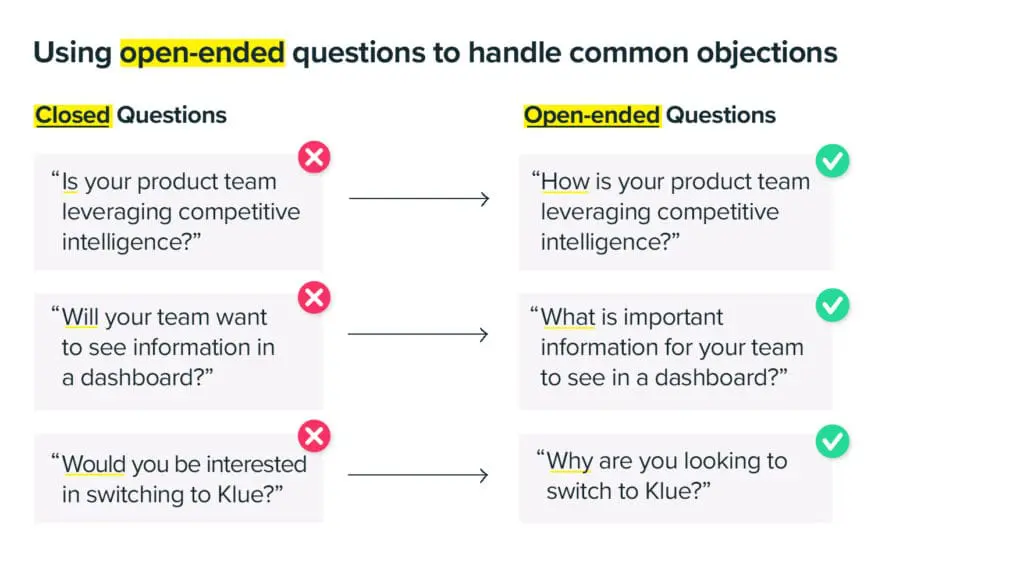

Active listening as part of the objection handling process involves your taking — as the name would imply — an active role in the conversation even when you’re not the one speaking.
Like asking open-ended questions, your goal is to play a complementary role in the prospect fleshing out their thoughts. This includes actions like:
Everyone wants to feel heard and understood. If you can accomplish this by being an active participant in the conversation as a listener, you will be more likely to hit all four objectives laid out in the second step of the Objection Handling Pyramid.
Once your trustworthiness is established through active listening and asking open-ended questions, it’s time to focus on three broad objectives informing your objection handling process:
Competitors are always lurking in a deal. And you can bank on the fact that they’ve been planting seeds of doubt with the buyer. Your sales team can’t be oblivious to the fact that this is happening.
“You need to prepare the buyer to talk to your competition. We can’t be ignorant and think the buyer is just talking to us,” said Kevin ‘KD’ Dorsey, VP of Inside Sales at PatientPop, at the Competitive Enablement Summit.
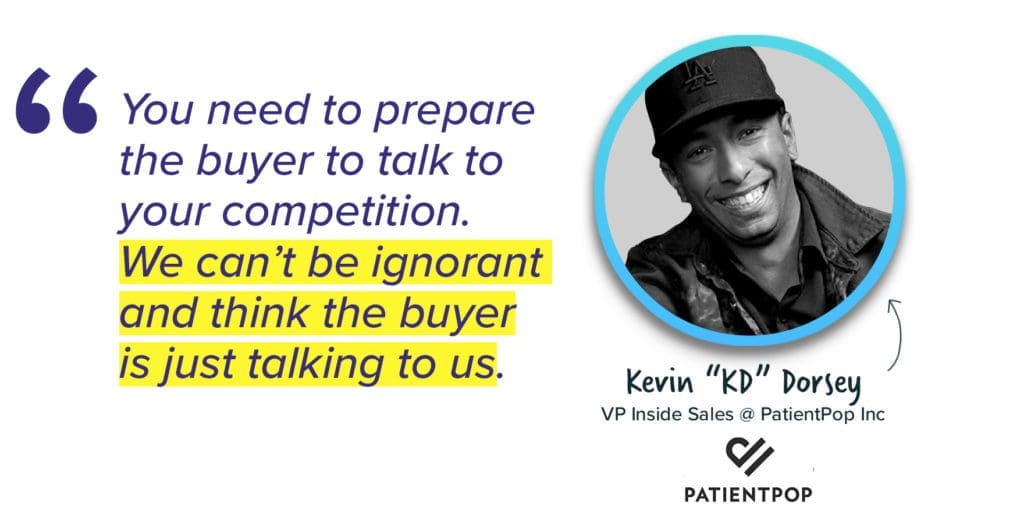

Leverage open-ended questions to tease out a buyer’s doubts and the FUD a competitor is throwing at you. Then, do everything in your power to quash these doubts.
This will involve addressing, reframing, and redirecting the potential issue brought up by the prospect — but we’ll get into that later in the ‘approaches’ section of the objection handling pyramid.
You can’t always kick your competitor out of a deal with a quick dismissal. But what you can do is frame and shape the lens through which your prospect views their pains and potential solutions moving forward.
Build a narrative that compels the prospect to arrive at the answer on their own — a powerful story arc that teaches your prospect how to make the decision.
Ultimately, building this story — and positioning yourself as the trusted advisor along the way — will get you a leg up on your competition, explains Anthony Iannarino, author of ‘Eat Their Lunch: Winning customers away from the competition’.
“The person who teaches them how to make the decision is the person that they’re most likely to buy from,” he said during the keynote speech at the Competitive Enablement Summit.


If you want to close a deal, you’ll need to keep the buyer engaged. Luckily, handling objections shared by buyers is a perfect opportunity for you to do just that.
Negative feedback or uncertainty from the buyer actually opens up the conversation. And while it may seem negative at first glance, this is a much better scenario than your prospect half-heartedly nodding through a demo call.
For example, a common objection you’ve probably heard sounds something like, “Our current vendor already has this same functionality.”
This objection is probably partly true. But it’s also an opportunity for you to acknowledge the overlap, followed by educating the buyer on the important differences past the apparent similarities.
What’s more, if you’ve asked the right open-ended questions, you’ll have gleaned some information about what’s most important to them. Use that information to shine a light on how your product goes above the competition to address that pain point.
The claims a competitor makes about you can be organized into two broad categories: claims that are true (or a version of the truth) and claims that are not true.
Of course, nothing is entirely black or white. So let’s add a bit of important nuance to the true/not true dichotomy.
There are five types of claims, each of which demand a different approach to overcoming the prospect’s objection:
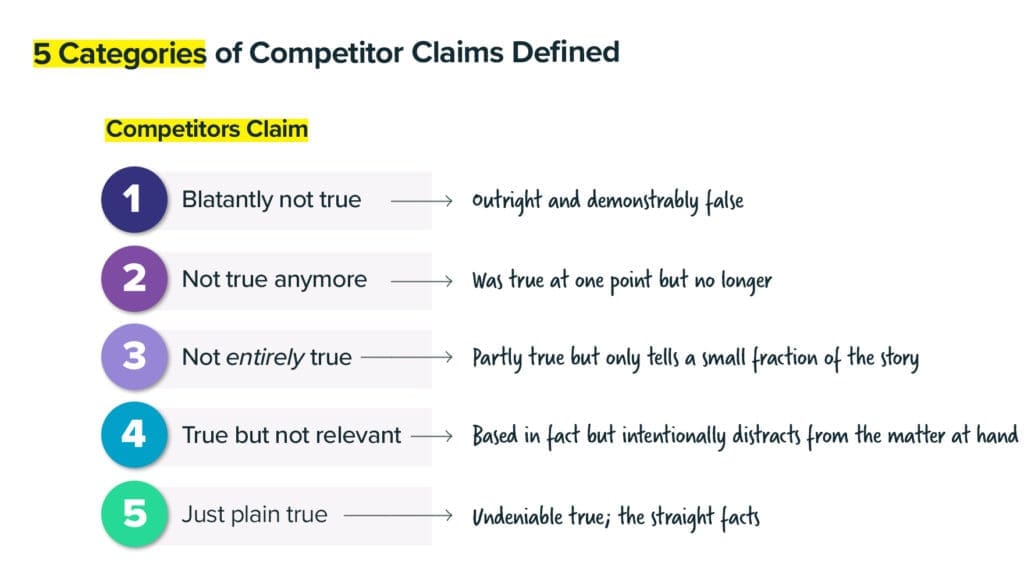

Once you’ve assessed exactly how true a claim is or isn’t, you’ve now got to determine how you’ll formulate your approach.
Move over annual recurring revenue, and make room for the ARR of objection handling techniques. A wonderful new acronym that stands for:
This structure is the guideline that you should follow depending on the validity of a competitor’s claims. Let’s dive into how you execute each approach.
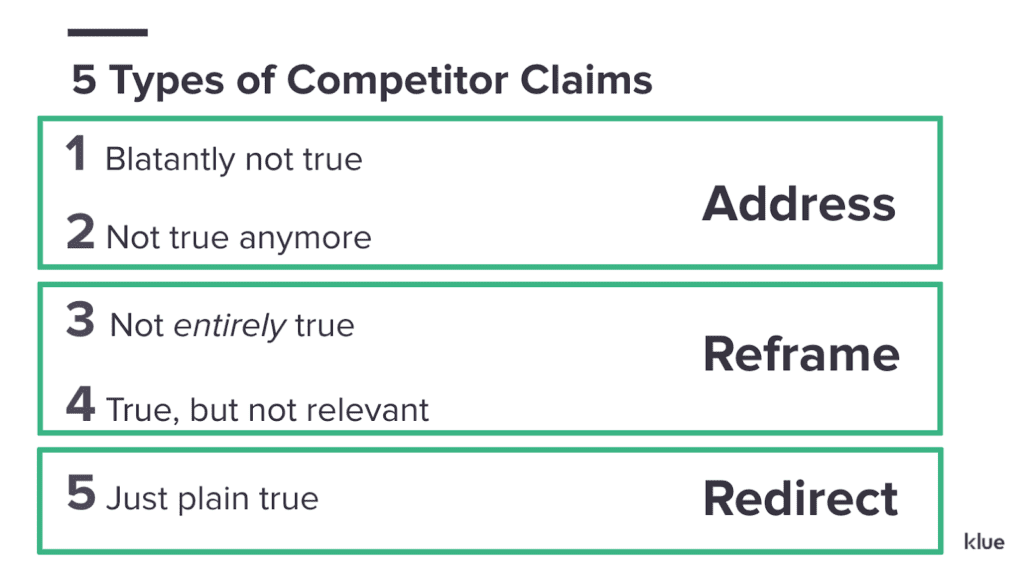

Addressing an objection is the most direct, straightforward approach to objection handling. A direct approach that attacks the falseness of what’s being claimed.
Whether the claim you’re countering is absurdly and outright false, or was perhaps true-ish at one point in time but now relies on outdated information, both claims should be exposed for their inaccuracy.
If you’re like us, nothing fires you up like an outright lie. Use that energy and go for the jugular to expose your competition!
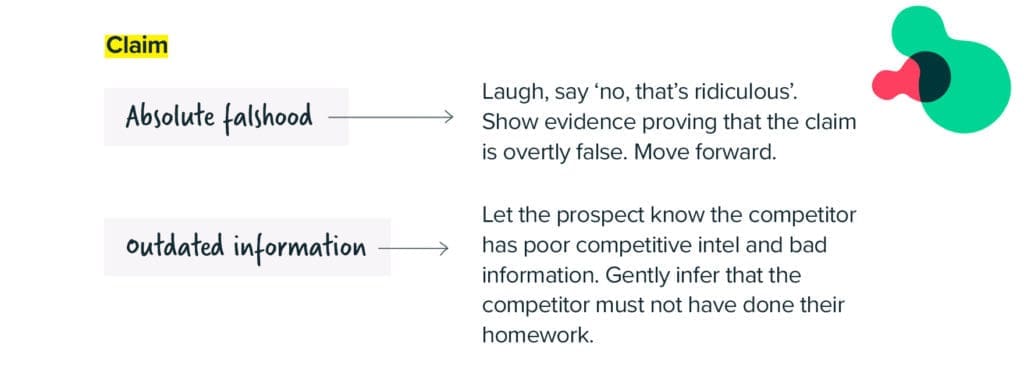

Reframing, as an objection handling technique, requires more finesse than claims that can be addressed head-on. That’s because the claims that require a reframing approach hold more truth to them.
Your product may very well be lacking a specific feature functionality your prospect is interested in. But instead of being on the defensive, avoiding the claim, or pulling something out of your butt, the best way to approach these sorts of claims is in the form of a question.
“Why is that feature/use case/integration important for you?”
The feature that a competitor demo’d and had your prospect drooling in the moment might not actually help them achieve their objectives. A good open-ended ‘why’ question can help them come to this realization on their own.
The feature that a competitor demo’d and had your prospect drooling in the moment might not actually help them achieve their objectives. A good open-ended ‘why’ question can help them come to this realization on their own.
Just like there are claims founded on plain falsehoods, some objections will be plainly true. Trying to refute or debate these points will amount to nothing — you’ll be fighting a losing battle.
In other words, don’t get stuck on a claim that is true. Acknowledge it, be humble and say something positive about the claim (or even one of your competitors) and then redirect the conversation towards what you DO offer.
It’s essential that you respond to the claim with a ‘yes’ and not a ‘no’ when possible, and always circle back to how your product or service does in fact address the perceived need of the prospect, even if your answer doesn’t directly line up with the claim.
If you’re in charge of training and enabling sellers, you’re probably familiar with sales reps looking at all the great prep work you’ve done and responding, “This is great, but just tell me what to say!”
As much as we’d all love there to be a producer in our ear telling us exactly what to say at the right time, the most effective objection handling battlecards and techniques should be based more on specific approaches as opposed to specific one-liners.
However, there is a lot of value in setting up your sales team for success with some tried and true examples of what to say based on the veracity of claims in order for you to better handle objections:
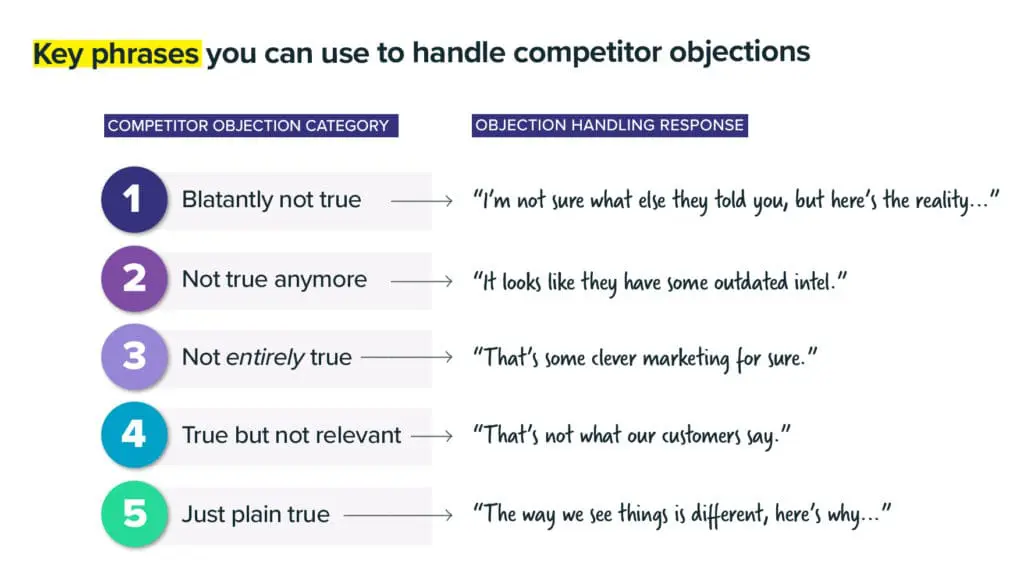

The purpose of an objection handling battlecard is to give sales people a way to respond to the most common objections they can expect to hear when going up against a particular competitor.
Since providing exact phrases and lines can come across as unnatural and rehearsed, the most effective objective handling cards are ones that showcase relevant talking points rather than specific keyphrases.
This will force the seller to explain things in their own words, opposed to regurgitating a prewritten sentence.
There are five key ingredients in the content formula for creating an objection handling battlecard.


Additionally, you can highlight real life examples of colleagues handling objections by leveraging conversational intelligence programs like Gong or Chorus. Take that competitive intelligence and use it within your competitive objection handling battlecards.
A battlecard is only valuable if it truly enables your team to close more deals. Follow the five steps above and you’ll be on your way to creating powerful objection handling cards that your team will love.
Although objection handling can feel complex, the secret to doing it effectively can be boiled down to three (and a half) steps.
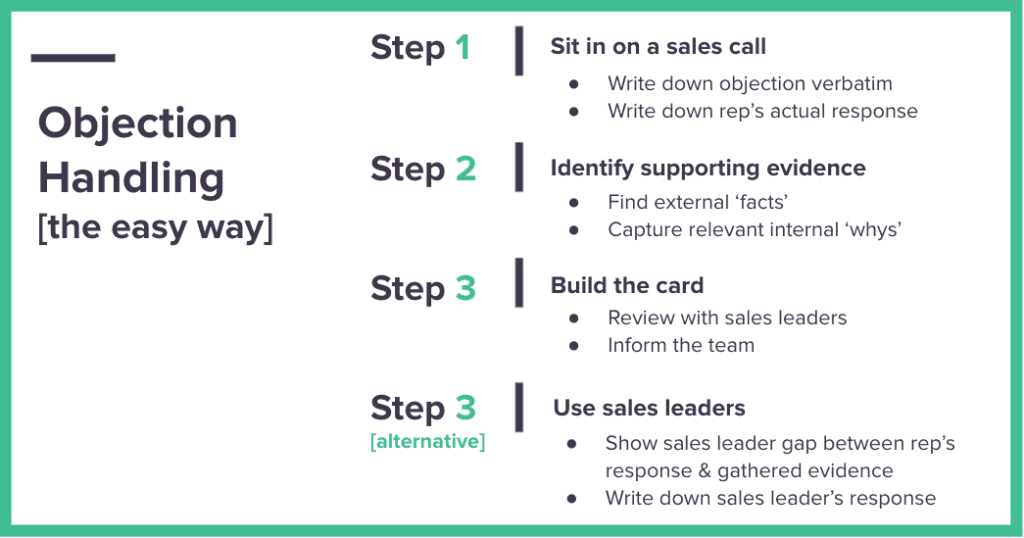

Perfection doesn’t exist. There is no perfect product, and consequently, you will always have to be mindful of, and find ways to overcome objections — be they true, untrue, or somewhere in between.
What’s important is for you to be aware of the common objections that arise for your team, to have powerful competitive intelligence about your competitors, and for you to enable your sales team to close more deals.
Some final reminders:
Keep these points in mind, do your diligence by following the Objection Handling Pyramid framework, curate killer content for your objection handling battlecards, and enable your team to close more deals.
That’s what your team needs to effectively handle objections, and become a pack of master salespeople.
(Catch our on-demand webinar ‘Sales Battlecard Deep Dive: Objection Handling’ below.)
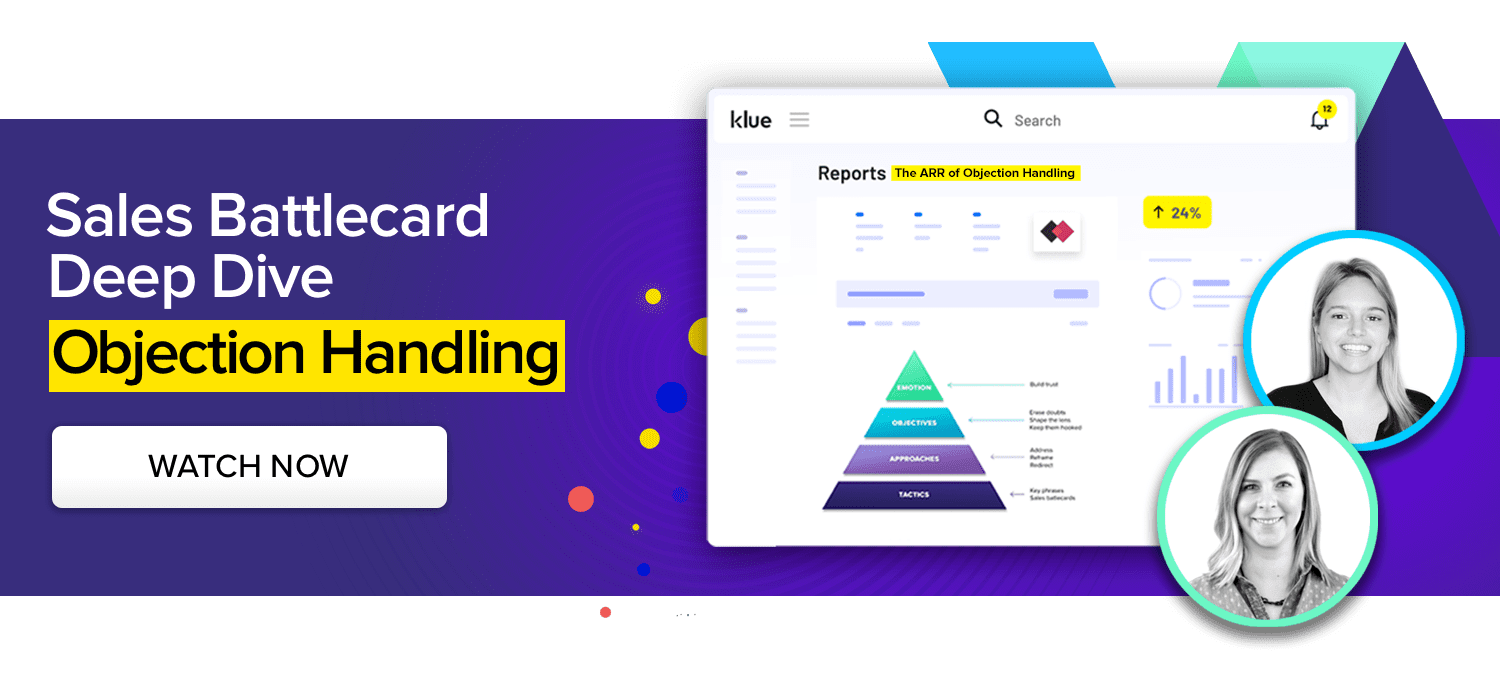



Competitive Enablement
The topic of Large Language Models (LLMs) has a lot of confusion. Here's what you need to know about how Klue is working with them.


Competitive Enablement
Product Marketing
If your competitive intel game is too strong for automation, too pure for data privacy, and too rebellious for accuracy — then Klue AI is probably not for you.


Let’s do it. Tell us a bit about yourself and we’ll set up a time to wow you.
Let's do it. Tell us a bit about yourself and we'll set up a time to wow you.
XLet's do it. Tell us a bit about yourself and we'll set up a time to wow you.
XSubscribe to get our latest AI functionality and news in your inbox.
XOur Buyer Pulse feature, set to launch in Q2 2024, offers valuable insights into the factors influencing buyer decisions in your pipeline. By signing up for the waitlist, we can better gauge interest and proactively engage with you to streamline the setup and integration process before the feature becomes widely available.
X